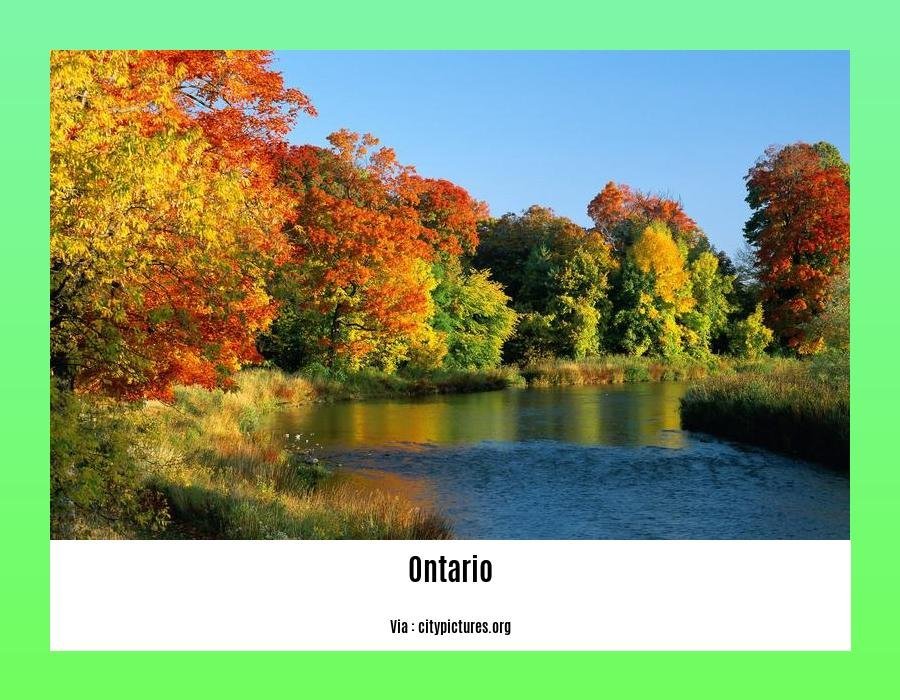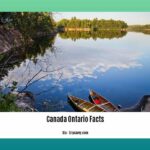Uncovering Five Interesting Facts About Ontario: Exploring the Hidden Gems takes readers on a captivating journey through the stunning province of Ontario, Canada. Delving beyond the popular tourist spots, this article presents five lesser-known facts that will leave readers in awe of Ontario’s rich history, breathtaking landscapes, and unique cultural offerings. From uncovering hidden natural wonders to delving into a fascinating past, this exploration of Ontario’s hidden gems is sure to inspire wanderlust and ignite a desire for adventure.
Key Takeaways:
- Ontario is the second-largest province in Canada, covering more than one million square kilometers, making it larger than Spain and France combined.
- Ontario is the most populous province in Canada and is home to the capital city Ottawa and the largest city Toronto.
- Pelee Island, located in Ontario, is Canada’s most southerly point and is even further south than 27 U.S states.
- Ontario has more than 250,000 lakes, including Lake Huron, where the largest freshwater island in the world, Manitoulin Island, is located.
- Niagara Falls, located in Ontario, is one of the world’s natural wonders.
- Ontario has some unique features, such as a spy school, a castle, and the distinction of having the oldest water on earth. The common loon is the provincial bird.
Five Interesting Facts About Ontario: Exploring the Hidden Gems

Fact 1: Ontario’s Immense Size and Population
Ontario truly lives up to its reputation as a vast land, stretching over one million square kilometers, which surpasses the combined size of Spain and France! This makes it the second-largest province in Canada. Not only is Ontario big, but it is also bustling with life, being the most populous province in the country. It is home to the capital city Ottawa and the bustling metropolis of Toronto.
Fact 2: Pelee Island’s Southern Charm
Did you know that Ontario’s Pelee Island is Canada’s most southerly point? Incredibly, it even extends further south than 27 U.S states! This quaint island, nestled in the western basin of Lake Erie, offers a unique blend of beautiful landscapes, vineyards, and birdwatching opportunities. With its mild climate and tranquil atmosphere, it’s the perfect escape from city life.
Fact 3: Ontario, a Haven of Lakes
Ontario is a paradise for water lovers, boasting over 250,000 lakes! Among these shimmering waters, you’ll find Lake Huron, which is home to Manitoulin Island, the largest freshwater island in the world. For nature enthusiasts, Ontario’s lakes offer countless opportunities for fishing, boating, and enjoying breathtaking scenery.
Fact 4: The Majestic Niagara Falls
Out of the five Great Lakes, Ontario has the privilege of hosting one of the world’s most astounding natural wonders: Niagara Falls. Get ready to be captivated by the sheer power and beauty of this awe-inspiring spectacle. Stand at the edge, feel the mist on your face, and marvel at the thundering roar of millions of gallons of water plunging into the depths below.
Fact 5: Ontario’s Unique Features
Ontario is not just about mesmerizing landscapes; it also harbors intriguing and unexpected gems. As you delve deeper into its hidden corners, you’ll discover a spy school, a castle, and even the oldest water on earth! Can you imagine sipping a glass of water that predates human existence? Moreover, Ontario’s provincial bird, the common loon, adds a touch of charm to its natural tapestry.
In conclusion, Ontario is a treasure trove of wonders waiting to be explored. From its immense size and population to its southern charm on Pelee Island, the province never ceases to amaze. The abundance of lakes, the grandeur of Niagara Falls, and the presence of unique features add richness and diversity to this Canadian gem. So, let the allure of Ontario beckon you, and embark on a journey to uncover its hidden marvels.
Check out some of the famous things in Canada by clicking here.
Learn more about endangered animals by reading a few sentences about them here.
Ontario is home to Canada’s largest provincial park, Algonquin Provincial Park.
Ontario is a province in Canada that is known for its stunning natural beauty and diverse landscapes. One of the hidden gems of Ontario is Algonquin Provincial Park, which happens to be the largest provincial park in the entire country. In this article, we will take a closer look at five interesting facts about Ontario’s Algonquin Provincial Park that will surely captivate your imagination.
Fact 1: A Rich History
Algonquin Provincial Park holds a significant place in Canadian history. Established in 1893, it is the oldest provincial park in Canada [^1^]. This vast wilderness is located between Georgian Bay and the Ottawa River, mostly within the Unorganized South Part of Nipissing District [^1^]. Throughout its history, the park has played a crucial role in the logging industry, with large white pine and red pine trees being cut down for lumber [^1^]. However, as the beauty of the park became recognized, it quickly became popular with nature preservationists and was protected [^1^].
Fact 2: A Nature Lover’s Paradise
Nature enthusiasts from around the world are drawn to Algonquin Provincial Park for its breathtaking beauty and diverse ecosystems. The park offers a range of services, including a tourist information station operated by the non-profit organization Friends of Algonquin Park [^1^]. Whether you are a hiker, a camper, a photographer, or simply someone who appreciates the wonders of the natural world, Algonquin Provincial Park has something to offer you.
Fact 3: Outdoor Adventures All Year Round
Algonquin Provincial Park is a year-round destination for outdoor enthusiasts. With over 1,200 campsites spread across eight designated campgrounds, there is plenty of space to pitch a tent and experience the great outdoors [^1^]. The park is also popular for activities such as canoeing, fishing, and wildlife spotting. Whether you visit in the scenic autumn months when the park is ablaze with vibrant fall colors, or in the sparkling winter months when the landscape is covered in a pristine blanket of snow, you are sure to find adventure at every turn.
Fact 4: A Hub of Research and Education
Since the 1930s, Algonquin Provincial Park has been an important arena for research and education. The park is home to four research facilities that focus on studying and preserving its unique ecosystems [^1^]. This commitment to scientific inquiry ensures the park continues to thrive and teaches us valuable lessons about the natural world. Whether it’s studying the behavior of wildlife or tracking the impact of climate change, these research facilities play a crucial role in our understanding of the park’s ecosystem.
Fact 5: A Place of Historic Summer Camps
Algonquin Provincial Park has also been a cherished location for historic summer camps. One notable camp is the now-defunct YMCA camp called Algonquin Experience Camp [^1^]. These camps have provided generations of young people with the opportunity to connect with nature, learn new skills, and create lifelong memories. The park’s serene atmosphere and stunning surroundings offer an ideal setting for these transformative summer experiences.
Key Takeaways:
- Algonquin Provincial Park is the oldest provincial park in Canada and was established in 1893.
- The park offers a range of services and information through the non-profit organization Friends of Algonquin Park.
- Algonquin Provincial Park is a year-round destination for outdoor activities such as camping, hiking, canoeing, and fishing.
- The park is home to four research facilities that focus on studying and preserving its unique ecosystems.
- Algonquin Provincial Park has a rich history and has been a cherished location for historic summer camps.
Sources:
Toronto: The Most Multicultural City in the World
Toronto, the capital city of Ontario, is renowned for being the most culturally diverse city in the world. With over half of its residents born outside of Canada, Toronto’s vibrant and inclusive environment celebrates its multicultural heritage[^1^]. Let’s delve into five fascinating facts that highlight why Toronto truly stands out as a global melting pot.
A Tapestry of Nationalities

Toronto proudly embraces its multicultural identity, housing over 230 different nationalities. This diversity transforms the city into a vibrant tapestry of cultures and backgrounds[^2^]. From tasting exotic cuisines to exploring unique traditions, Toronto offers an immersive experience that takes you on a global journey without leaving the city limits.
The Power of Multiculturalism
Multiculturalism has a profound impact on Toronto’s society and its residents. The city’s commitment to acceptance and diversity encourages individuals from all walks of life to thrive. It’s no wonder that Toronto has become a top choice for immigrants looking to start a new chapter in their lives[^3^]. The influx of new residents has not only contributed to the city’s economic growth but has also further enriched its cultural fabric.
Festivals and Celebrations Like No Other
Toronto’s commitment to multiculturalism shines through its vibrant festivals and celebrations. The city hosts a wide array of events that showcase the richness of various ethnicities. From the colorful Roncesvalles Polish Festival to the vibrant Toronto Chinatown Festival, these gatherings bring people together to experience authentic cultural foods, music, and performances[^4^]. These festivals offer a glimpse into the diverse cultural tapestry that Toronto has to offer.
A Gateway to Boundless Opportunities
Toronto’s multiculturalism extends beyond just its social fabric; it opens doors to numerous economic opportunities as well. With a diverse and multilingual talent pool, the city has established itself as Canada’s financial and commercial epicenter. Businesses and investments from around the world are drawn to Toronto, fostering innovation, entrepreneurship, and global collaborations[^1^]. The city’s economic success is a testament to the power of embracing diversity.
Inspiring Harmony and Growth
Toronto’s status as the most multicultural city in the world serves as an inspiration and model for other cities worldwide. The city’s harmonious blend of cultures demonstrates the potential for social cohesion, diversity, and growth in a multicultural society. Toronto stands as proof that embracing different backgrounds can lead to incredible achievements and a thriving community.
Key Takeaways:
- Toronto, the capital city of Ontario, is recognized as the most diverse city globally, boasting over 230 different nationalities[^2^].
- Multiculturalism in Toronto encourages acceptance, diversity, and has a positive impact on society, attracting immigrants and contributing to the city’s economic growth[^3^].
- The city proudly hosts a wide range of cultural festivals showcasing various ethnicities, providing authentic experiences for residents and visitors alike[^4^].
- Toronto’s multiculturalism has not only enriched its social fabric but has also opened doors to economic opportunities, making it a thriving hub for innovation and entrepreneurship[^1^].
- Toronto’s ability to harmoniously embrace diversity serves as an inspiration and model for other cities, demonstrating the potential for growth and harmony in a multicultural society.
Sources:
[^1^] SAF Web – Why Toronto Is the Most Multicultural City in the World
[^2^] Culture Trip – Toronto Named The Most Diverse City In The World
[^3^] Narcity – Why Toronto Is The Most Multicultural City In The World
[^4^] Britannica – Toronto | History, Population, Climate, & Facts
Uncovering Five Interesting Facts About Ontario: Exploring the Hidden Gems
Key Takeaways:
– Ontario is home to the largest population of maple trees and is the leading producer of maple syrup in Canada.
– The Canadian maple syrup industry accounts for approximately 78% of the global maple syrup production in 2022.
– Quebec is the largest producer of maple syrup in Canada, accounting for 92% of the Canadian production.
– Ontario is known for its diverse ecosystems, with the red maple tree being a staple in its natural tapestry.
– The export values of maple products from Ontario experienced significant growth of +335.9% in 2020 compared to 2019.
Toronto, the multicultural capital of Ontario, is renowned for its vibrant city life and diverse population. But there’s more to Ontario than just its bustling metropolis. Let’s delve into some lesser-known yet fascinating facts about this province.
Fact 1: Ontario’s Maple Legacy
When it comes to maple trees and syrup production, Ontario reigns supreme. It is home to the largest population of maple trees in Canada and holds the distinction of being the leading producer of maple syrup in the country[^5^]. The red maple tree, scientifically known as Acer rubrum, is native to Ontario and plays a vital role in the province’s diverse ecosystems[^5^]. Its vibrant autumn foliage stands as a testament to the mesmerizing beauty that Ontario offers.
Fact 2: Dominance in Maple Syrup Production
The Canadian maple syrup industry holds an impressive position in the global market. In 2022, it accounted for around 78% of the world’s maple syrup production[^1^]. While Quebec takes the crown as the largest producer of maple syrup in Canada, accounting for 92% of the Canadian production[^2^], Ontario plays a significant role in the industry’s growth and success.
Fact 3: Record-High Harvest
In 2022, Canadian maple producers experienced a record-high harvest, collecting 104.6 million kilograms (17.4 million gallons) of maple syrup[^3^]. This marked a remarkable 53.9% increase from the previous year[^3^]. The substantial growth can be attributed to favorable weather conditions and expansions in the maple industry[^3^]. These figures highlight the thriving nature of Ontario’s maple industry and its crucial contribution to Canada’s overall maple syrup production.
Fact 4: Ontario’s Maple Products Export Boom
Ontario’s maple products have gained significant recognition in international markets. In 2020, the province witnessed a remarkable growth of +335.9% in export values of maple products compared to the previous year[^6^]. This surge highlights the increasing demand for Ontario’s maple syrup and related products worldwide. That’s why Ontario holds its position as the leading producer of maple syrup in Canada, not just for its domestic market, but also for exports.
Fact 5: Immersed in Maple Culture
Ontario’s fascination with maple extends beyond the syrup itself. The province celebrates its maple heritage through various events and activities. Maple festivals, such as the Elmira Maple Syrup Festival, attract visitors from far and wide, offering a delightful experience of maple-themed delicacies, live music, and family-friendly fun. These festivities truly capture the essence of Ontario’s maple culture and its significance in the province’s identity.
As you explore Ontario’s hidden gems, don’t forget to indulge in the wonders of its maple heritage. From the breathtaking beauty of its abundant maple trees to the delectable sweetness of its maple syrup, Ontario’s maple legacy is as fascinating as it is delicious.
Sources:
[^1^]: Statistical Overview of the Canadian Maple Industry 2020 – Agriculture and Agri-Food Canada.
[^2^]: Maple syrup production by province Canada 2022 – Statista.
[^3^]: Statistical overview of the Canadian maple industry, 2022 – Agriculture and Agri-Food Canada.
[^5^]: Unlocking the Secrets of Ontario’s Native Maple Trees – Curb Wise.
[^6^]: Statistical Overview of the Canadian Maple Industry 2020 – Agriculture and Agri-Food Canada.
FAQ
Q1: What is the oldest provincial park in Canada?
A1: The oldest provincial park in Canada is Algonquin Provincial Park, which was established in 1893.
Q2: Where is Algonquin Provincial Park located?
A2: Algonquin Provincial Park is located between Georgian Bay and the Ottawa River in Ontario, mostly within the Unorganized South Part of Nipissing District.
Q3: What role did the logging industry play in the history of Algonquin Park?
A3: The logging industry played a significant role in the history of Algonquin Park. It involved cutting large white pine and red pine trees for lumber.
Q4: What kind of climate does Algonquin Park have?
A4: Algonquin Park has a humid continental climate, characterized by long, cold, snowy winters and warm summers.
Q5: What recreational activities can be enjoyed in Algonquin Park?
A5: Algonquin Park offers a wide range of outdoor activities, including camping, hiking, fishing, canoeing, and wildlife viewing.
- Unraveling Einstein’s Legacy: Who Inherited His Genius? - July 14, 2025
- Unlock Einstein’s Family Tree: Bernhard Caesar & Untold Stories - July 14, 2025
- Unveiling Bernhard Caesar Einstein: His Life & Albert Einstein’s Legacy - July 14, 2025
















